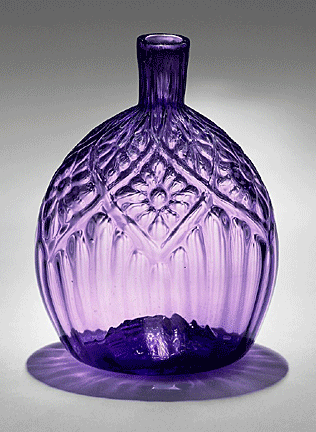 Glassmaking
was the first recorded industry in the New World, with "glasshouse"
factories built in the woods in 1607 and 1621 a half mile from
Jamestown in what was to become the Virginia Colonies. But
glassmaking existed for centuries before this.
Glassmaking
was the first recorded industry in the New World, with "glasshouse"
factories built in the woods in 1607 and 1621 a half mile from
Jamestown in what was to become the Virginia Colonies. But
glassmaking existed for centuries before this.
The making of glass dates back to antiquity. Pliny wrote that
Phoenician sailors, returning from Egypt to Syria, were transporting
a cargo of soda. A storm drove them ashore. To dry off and cook, the
men made a fire of seaweed and rested their pots on the soda; that
and the sand and ashes on the seaweed formed the first manmade
glass.
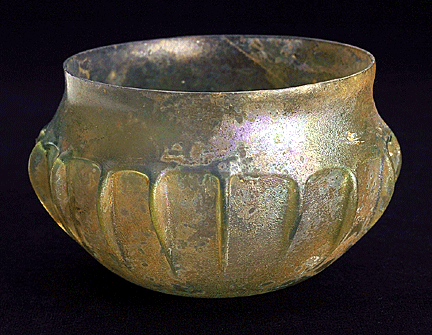 Syrian
craftsmen invented the glass-forming technique of glassblowing using
clay pipes in the 1st century B.C.E., somewhere along the coast of
what is now Syria and Palestine. But it was the ancient Egyptians
that perfected the technique for making glass.
Syrian
craftsmen invented the glass-forming technique of glassblowing using
clay pipes in the 1st century B.C.E., somewhere along the coast of
what is now Syria and Palestine. But it was the ancient Egyptians
that perfected the technique for making glass.
When the Romans occupied Egypt, they saw the potential for making
everyday glass objects and motivated the Egyptians to develop the
glassmaking methods further. Glassmaking all but disappeared in the
5th century when barbarians sacked Rome. However, early Christians
continued to use glass for sacred mosaics and church windows until
the Renaissance.
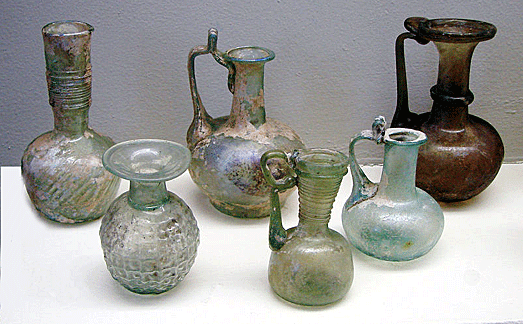
Meanwhile, glassmaking reached Venice by way of traders from Asia.
But it could as easily been Roman glassmakers, escaping from the
sack of Rome, who, seeking refuge in Venice, brought their craft
with them. And it was Venetians who kept it alive during the Dark
Ages. By the 13th century, the Venetians had earned a reputation for
beautiful glass. By 1591 glass houses were so numerous, the Venetian
City Council regarded them as a fire hazard, so it passed laws
requiring all glassmaking to be done on the Island of Murano in the
Venetian Lagoon. Here, Venetians glassmakers carried on their craft,
producing cristallo, a clear, fine glassware by employing a new
technique, mold-blowing, in which they blew molten glass into wood
and metal molds.
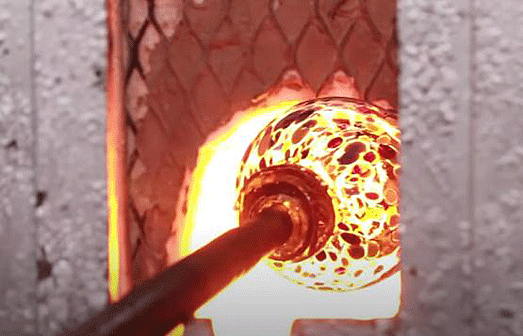
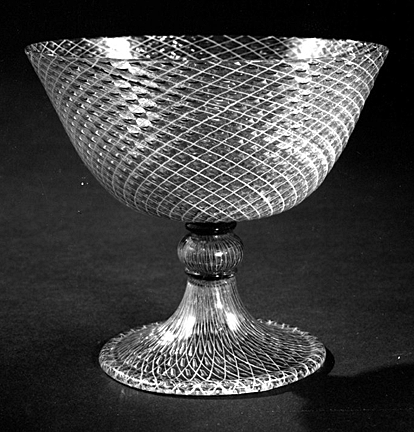 The
glassblowing craft was passed from father to son or from master to
apprentice. From its beginning, glassmakers kept the formulas and
techniques they used a secret on penalty of death.
The
glassblowing craft was passed from father to son or from master to
apprentice. From its beginning, glassmakers kept the formulas and
techniques they used a secret on penalty of death.
In spite of penalties imposed by the new laws, Venetian glassmakers
traveled from Murano, spreading their secrets across Europe and
England. During the reign of Elizabeth I, English glassmakers made a
new beginning with flint with the addition of lead, making the glass
brilliant and comparatively soft; so it was easy to cut or etch the
surface.
Glassmaking in the New World
By 1606, during the reign of England's James I, the first permanent
English-speaking colony in America was set up in Virginia by the
London Co. One of the first things the colonists asked to be sent to
them was glass. But the company, realizing the difficulty of
transporting this fragile commodity across the ocean, sent, in 1608,
eight skilled workmen to teach the Virginians how to make glass.
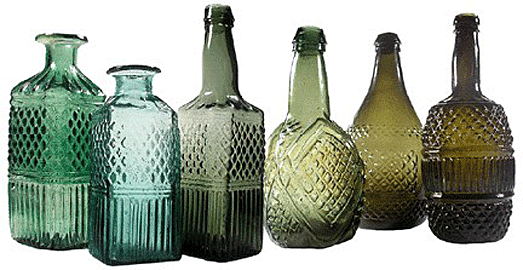
Glassmakers established a dozen or so more of these glass
“factories” in Salem, Massachusetts, New York, and Philadelphia in
the 170 years before the Revolution, but none of them succeeded. It
was Caspar Wistar, a German button-maker, who established the first
successful glass factory in America, in Salem County, New Jersey.
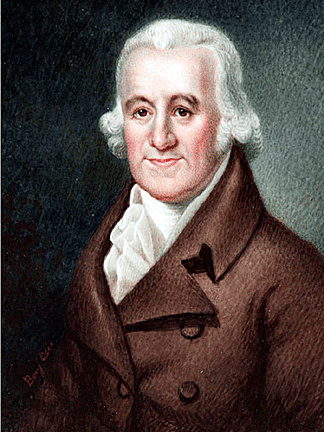 It
wasn’t until Caspar Wistar, a German button-maker, established the
first successful glassmaking operation in Salem County, West Jersey,
in 1739 that the glass industry took hold in the New World.
It
wasn’t until Caspar Wistar, a German button-maker, established the
first successful glassmaking operation in Salem County, West Jersey,
in 1739 that the glass industry took hold in the New World.
Born in 1696, in Wald-Hilsbach, Baden, near Heidelberg, Germany,
Wistar arrived in America in 1717, landing in Philadelphia where he
began making brass buttons, which he advertised as lasting seven
years.
Wistar was an entrepreneur extraordinaire, establishing a retail
store in Philadelphia, as well as getting involved in the real
estate market there.
In 1738 Wistar bought about 2,000 acres of pine woods near the
village of Allowaystown, West Jersey. He used the wood to fuel his
factory furnace and the rich sand to provide silica for making
glass. A nearby river provided convenient transportation to send his
glassware to market.
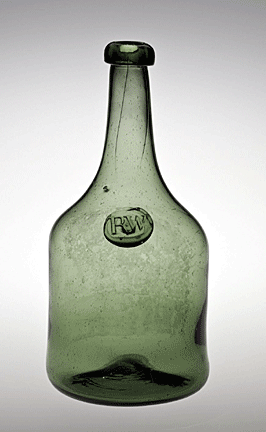 Unfortunately,
Wistar didn’t know how to make glass. But that didn’t stop him. He
hired four glass craftsmen and asked them to come to America and
teach him and his son, Richard, how to make glass. He gave them each
shares in the project for their instruction. By the following year,
Wistar’s first furnace was operational, producing flat glass for
windows and various types of utility and beverage bottles in various
colors, including striking green, blue, amber, and various shades of
brown.
Unfortunately,
Wistar didn’t know how to make glass. But that didn’t stop him. He
hired four glass craftsmen and asked them to come to America and
teach him and his son, Richard, how to make glass. He gave them each
shares in the project for their instruction. By the following year,
Wistar’s first furnace was operational, producing flat glass for
windows and various types of utility and beverage bottles in various
colors, including striking green, blue, amber, and various shades of
brown.
The plant flourished for 40 years around a small village of workers'
homes, factory buildings, general store, granary, barns, a
wagon-house, and manager's house. When Caspar died in 1762, he left
Richard in charge of the glass factory. But the plant closed
permanently during the American Revolution.
